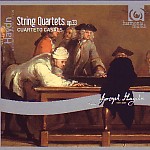Haydn’s Op. 33 string quartets have not been as well served on disc as has the Op. 20 set. The reasons are obvious: Op. 20 features many examples of Sturm und Drang angst, and the three fugal finales are justly famous. The Op. 33 set, on the other hand, marks the maturity of Haydn’s (and the Classical period’s) musical sense of humor, something that few musicians understand, and even fewer project effectively. This humor manifests itself in many ways, from the madcap antics of the “Joke” quartet to the melodramatic excess of the G major quartet’s slow movement, dismissed at the end by a loud pizzicato “plonk” (here correctly played forte).
The Casals Quartet is enormously talented, and some of the performances here are absolutely brilliant. The “Bird” quartet, for example, features miracles of light, characterful articulation in its outer movements. All six of the scherzos, which Haydn used to replace the usual minuet, move at sprightly tempos that really do suggest that “really new minuet” that Haydn famously wished someone would invent. There is very little to criticize in the B-flat or G major quartets either. The pizzicato coda to the former’s finale is deliciously done, seeming to evaporate into thin air, and the group’s wide dynamic range makes the most of the many surprises that abound in these works.
Against this, we must offset two small and one large disappointment. The first small disappointment is a finale of the B-minor quartet whose tempo in the main theme, however exciting, comes across as merely erratic and scrambled. Second, the Andante slow movement of the D major quartet begins with a sustained note for first violin more than four bars long, under which the second violin and viola play one of those portato motives that Haydn, particularly in pianissimo as here, expected would take a warm and healthy vibrato. Here the players treat the music with some of that dry-as-dust timbre that unfortunately passes for “authenticity” nowadays.
Finally, the “Joke” quartet really misfires. Comedy, in music as in drama, really is a function of timing, and here the players clearly don’t get the joke. The trio of the scherzo, with its outrageous glissandos generously observed, has the juice sucked out of it by being separated from the main body of the movement by a huge, gratuitous pause, and by being played at a weirdly gutless mezzo-piano. The finale’s coda only works if it’s played strictly in time–the humor is written into the notation. Instead, the Casals group executes a huge, mannered ritard followed by a sudden return to tempo primo, as if saying: “HERE CO-O-O-MES THE JO-O-O-O-KE, (a tempo) HAHA!”
Like many young ensembles today, for all the care and fire the quartet brings to this music, there’s a certain lack of spontaneity and naturalness. At its best, the playing avoids turning mannered and stiff, but elsewhere it seems that the need to adhere to certain trendy stylistic parameters (particularly regarding timbre) leads to a labored, self-conscious quality. It will be interesting to see, as the group matures, if they outgrow this tendency and learn to play the music with the true cantabile tone and effortless phrasing that allows all of Haydn’s humor to register as he so clearly intended. Meanwhile, four or five successes out of six remains a pretty impressive average, the number of good ideas far exceeds the bad. Recommended.
































